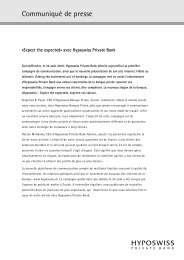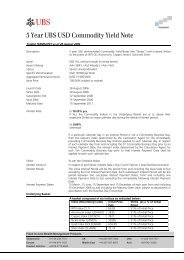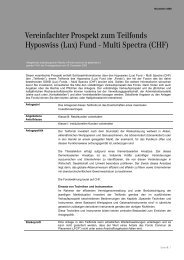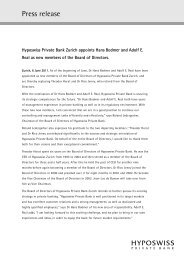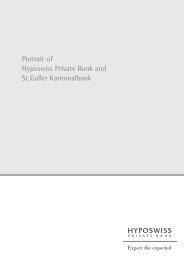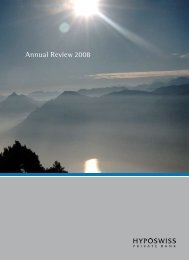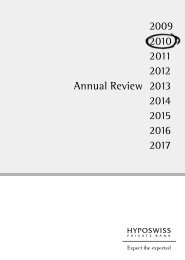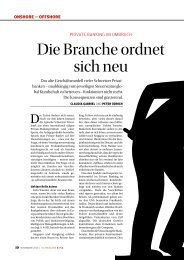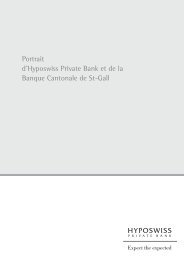Investment Strategy - Hyposwiss Privatbank AG
Investment Strategy - Hyposwiss Privatbank AG
Investment Strategy - Hyposwiss Privatbank AG
You also want an ePaper? Increase the reach of your titles
YUMPU automatically turns print PDFs into web optimized ePapers that Google loves.
<strong>Investment</strong> <strong>Strategy</strong><br />
Economy and Financial Markets<br />
October 2010
Title Picture<br />
Beach at Jökulsarlon, Iceland<br />
Photo: Roland Gerth<br />
Impressum<br />
Issuer<br />
<strong>Hyposwiss</strong> Private Bank Ltd.<br />
Bahnhofstrasse/Schützengasse 4<br />
CH-8021 Zurich<br />
Phone +41 (0)44 214 31 11<br />
Fax +41 (0)44 211 52 23<br />
www.hyposwiss.ch<br />
Analysts<br />
Caroline Hilb Paraskevopoulos<br />
Thomas Jäger<br />
Thomas Stadelmann<br />
Dr. Alexander F. Galli<br />
Editorial deadline<br />
September 24, 2010<br />
Release<br />
Monthly<br />
Contents<br />
1 Editorial<br />
Commodities as a hedge – myth or reality?<br />
2 Economy<br />
Is the strong franc slowing things down?<br />
4 Interest rates and yields<br />
All options now open<br />
5 Equity markets<br />
A more positive trend<br />
6 Currencies<br />
More than just a quest for security<br />
7 Commodities<br />
No consistent picture<br />
8 <strong>Investment</strong> <strong>Strategy</strong><br />
Matter of trust<br />
Enclosure<br />
Topic of the month:<br />
International trade –<br />
return to previous growth<br />
Thomas Stadelmann,<br />
<strong>Strategy</strong> Analyst<br />
Recommended Stocks
Editorial<br />
Commodities as a hedge – myth or reality?<br />
Dear Investor,<br />
Although there is little inflationary pressure<br />
around at the moment and many central banks<br />
are warning more of deflationary<br />
risks, a large number of investors<br />
fear that inflation could<br />
rise in the future and are wondering<br />
how to protect themselves<br />
against such a scenario. Commodity<br />
investments are often<br />
mentioned in this context. But do<br />
commodities really offer an effective<br />
hedge against inflation?<br />
There are various reasons why the prices of<br />
goods rise, thus eroding the value of money. In<br />
this context we can distinguish between «real»<br />
inflation and «monetary» inflation. Real inflation<br />
follows a cyclical trend driven by an economic<br />
upturn. When the economy is at the high<br />
point of the cycle, it runs short of capacity and<br />
is no longer able to meet increased demand for<br />
either personnel goods or commodities. Prices<br />
rise accordingly at a rate of 2% to 3% per annum.<br />
When the economy slows down again,<br />
the pressure on prices also eases, albeit with<br />
some time lag, and inflation rates fall again.<br />
Monetary inflation, on the other hand, is<br />
caused by an excess of money. This type of inflation<br />
is associated with a loss of confidence in<br />
the central bank, which has neglected its principal<br />
task of guaranteeing price stability. This<br />
also undermines confidence in the currency in<br />
question. The value of that currency then falls,<br />
which further fans the flames of inflation by<br />
pushing up the price of imported goods. This<br />
results in inflation rates well above 5% and a<br />
rising trend. Once monetary inflation has got<br />
out of hand, it can only be reined in through<br />
radical monetary and fiscal policies with all the<br />
negative consequences these entail for the<br />
economy.<br />
Like real inflation rates, commodity prices depend<br />
on the current stage in the economic cycle.<br />
When the economy is booming, more commodities<br />
are required and prices are pushed up<br />
by the increased demand. Commodities can<br />
therefore protect investors from a rise in real inflation<br />
since both are largely influenced by the<br />
same factors. Monetary inflation is a diffe rent<br />
matter. This type of inflation does not increase<br />
actual production of goods. There is therefore<br />
no increase in demand for commodities and<br />
hence no rise in commodity prices. In such an<br />
environment real assets such as land and property<br />
are a much more suitable means of hedging<br />
against inflation. As central banks need to<br />
respond to monetary inflation by raising key interest<br />
rates sharply, money market interest rates<br />
rise particularly steeply. Fixedterm and fiduciary<br />
investments are therefore also an attractive<br />
alternative. Thus, in the early 1990s Switzerland<br />
saw the threemonth Libor rate climb well<br />
above 8% as the Swiss National Bank sought<br />
to combat inflation.<br />
Dr. Thomas Stucki<br />
Chief <strong>Investment</strong> Officer<br />
October 2010 <strong>Investment</strong> <strong>Strategy</strong> 1
Economy<br />
Is the strong franc slowing things down?<br />
The Swiss economy has turned in a spirited<br />
economic performance this year, but the<br />
strong franc and the global economic outlook<br />
are also casting a shadow over the outlook.<br />
In the second quarter of this year, the Swiss<br />
economy grew more strongly than expected.<br />
Swiss GDP grew by 1% quarteronquarter in<br />
Q1 2010, before expanding by a further 0.9%<br />
in Q2. <strong>Investment</strong> activity in particular surged<br />
by 2.4% in comparison with the first quarter,<br />
which saw it contract by 1.4%. By contrast, export<br />
growth declined slightly from 3.7% in Q1<br />
to 1.7% in Q2. Consumer spending remained<br />
stable compared to the first quarter. However,<br />
consumer spending had already proved more<br />
robust than expected during the crisis, when it<br />
stabilized the economy. The industrial sector in<br />
particular benefited from brisk investment activity<br />
and growing demand for exports, with Q2<br />
once again seeing Swiss industrial output expand<br />
strongly. The increase in output came to<br />
7.8% yearonyear and 5.7% quarteronquarter.<br />
New orders also rose significantly, as did<br />
orders on hand. Sales increased, with exports<br />
playing a key role. The strongest sectors included<br />
the chemical industry, the electrical and<br />
precision engineering industries and the metal<br />
industry, all of which reported growth rates of<br />
more than 10%.<br />
Growth driven by exports<br />
The Swiss economic recovery was very much<br />
driven by the revival of global trade and growing<br />
demand for exports. Switzerland's most important<br />
trading partner is Germany (19.4%),<br />
followed by the US (9.7%). However, Asia and<br />
South America account for an increasingly<br />
large proportion of exports. In 2009, goods<br />
worth CHF 34.4 billion were exported to Asia.<br />
Although the volume of exports bound for<br />
China is still roughly equal to the volume sold<br />
to Austria, the growth rates for this region are<br />
impressive. Also, exports to Asia came under<br />
less pressure during the recession. While exports<br />
to Germany have slipped back from more<br />
than CHF 40 billion in 2008 to around CHF 35<br />
billion, over the same period Asianbound tra<br />
2<br />
<strong>Investment</strong> <strong>Strategy</strong> October 2010<br />
ding volumes remained steady at just under<br />
CHF 35 billion. It is not just that Swiss trading<br />
partners are more globally diversified than they<br />
were a few years ago: their product ranges are<br />
also more diversified. Traditional Swiss products<br />
are still the big hits, however. Chemical<br />
products are most in demand abroad (accounting<br />
for 41% of exports), followed by machine<br />
exports, which account for 18%. Watches ac<br />
Economic Snapshot (Figures as of Sep 24, 2010)<br />
Switzerland: a solid recovery takes place<br />
6<br />
4<br />
2<br />
0<br />
-2<br />
-4<br />
Inflation rate<br />
Switzerland Germany Eurozone USA Japan<br />
Real GDP QoQ 0.9% 2.2% 1.9% 1.6% 0.4%<br />
Inflation YoY 0.3% 1.0% 1.6% 1.1% 0.9%<br />
Unemployment rate 3.6% 7.6% 10.0% 9.6% 5.2%<br />
Real GDP growth<br />
(%-change qoq, annualized)<br />
KOF-leading indicator<br />
(r. h. scale)<br />
00 01 02 03 04 05 06 07 08 09 10 11<br />
Source: Bloomberg<br />
3.00<br />
2.50<br />
2.00<br />
1.50<br />
1.00<br />
0.50<br />
0<br />
-0.50<br />
-1.00<br />
-1.50<br />
-2.00<br />
Source: Thomson Reuters Datastream
Switzerland: strong industry<br />
20<br />
15<br />
10<br />
5<br />
0<br />
-5<br />
-10<br />
-15<br />
-20<br />
Industry expands<br />
count for around 8% of all Swiss exports. In recent<br />
years, the proportion of chemical products<br />
has steadily increased, while machinery's<br />
share has declined.<br />
Is the strong franc slowing things down?<br />
Despite all the global shifts, 50% of all exports<br />
still go to the eurozone. According to a survey<br />
conducted by the KOF economic research unit,<br />
60% of transactions are concluded in euros,<br />
PMI (leading indicator)<br />
Industry contracts<br />
-20<br />
2000 2001 2002 2003 2004 2005 2006 2007 2008 2009 2010<br />
Source: Thomson Reuters Datastream<br />
20<br />
15<br />
10<br />
5<br />
0<br />
-5<br />
-10<br />
-15<br />
30% in Swiss francs and around 10% in other<br />
currencies. The 12% decline in the value of the<br />
euro represents a stumbling block for Swiss exporters.<br />
However, in the short term the problem<br />
is less acute than might be expected: supply<br />
contracts are often fixed and export companies<br />
are able to hedge against exchange rate movements<br />
with financial instruments. In the long<br />
term, though, a strong Swiss franc against the<br />
euro would put Swiss exporters at a competitive<br />
disadvantage since it would make their<br />
products more expensive. That said, in South<br />
America and Asia Swiss companies have<br />
gained a competitive advantage in spring<br />
thanks to currency movements. And even in Europe,<br />
the currency alone is unlikely to be the decisive<br />
factor as many Swiss exporters are<br />
highly specialized niche players. A strong<br />
franc can also be expected to put pressure on<br />
the future margins of some exporters. So while<br />
the strength of the franc will exert a braking effect,<br />
this effect on its own is likely to be smaller<br />
than feared by some pessimistic commentators.<br />
Outlook for 2011<br />
The State Secretariat for Economic Affairs<br />
(SECO) has sharply upgraded its GDP growth<br />
forecasts for 2010. This June, SECO was still<br />
expecting this year's GDP growth to come to<br />
1.8%. After a brisk economic recovery in the<br />
first two quarters, the Swiss government’s Expert<br />
Group on Economic Forecasts also upgraded<br />
its predictions to 2.7%, but downgraded<br />
its forecasts for 2011. In particular, the<br />
positive contribution of the export sector can be<br />
expected to be smaller next year. SECO mainly<br />
attributes this trend to the strong franc and to<br />
the outlook for the global economy. Thus,<br />
SECO anticipates 7% yearonyear export<br />
growth in 2010, but dropping to just 2.2% in<br />
2011. We agree with SECO's assessment that<br />
2011 will see a slowdown in economic momentum<br />
after an exceptionally strong 2010. Growth<br />
will remain in the positive range, however. The<br />
strong franc will certainly slow down the export<br />
sector. But the main reason for the falloff in demand<br />
growth will be slower momentum at the<br />
global level. n<br />
October 2010 <strong>Investment</strong> <strong>Strategy</strong> 3
Interest rates and yields<br />
All options now open<br />
The Swiss National Bank's decision to leave<br />
interest rates unchanged at their present<br />
expansionary level was in line with our predictions.<br />
What surprised us more was the sharp<br />
downgrading of the SNB's inflation expectations.<br />
This statement means the SNB is keeping<br />
all its options open.<br />
As expected, the Swiss National Bank (SNB) left<br />
its target band for the threemonth Libor rate at<br />
0%–0.75%. Monetary policy remains as expansionary<br />
as ever: the SNB intends to keep the<br />
Libor in the lower range of the band. For 2010,<br />
the SNB expects GDP growth to be in the region<br />
of 2.5%, but sees economic momentum weakening<br />
in 2011. The SNB identifies the causes of<br />
this slowdown as the strength of the Swiss franc<br />
and weaker global growth momentum.<br />
Inflation forecasts significantly downgraded<br />
More striking than the SNB's economic forecasts<br />
are its inflation predictions. Thus, the conditional<br />
inflation forecast is significantly lower<br />
than in June and the SNB is now expecting inflation<br />
to average just 0.7% in 2010 and 0.3%<br />
in 2011, and only expects it to rise to 1.2% in<br />
2012. The SNB is basing these inflation predictions<br />
on the assumption that interest rate policy<br />
will remain unchanged. So, even the SNB sticks<br />
to its highly expansionary monetary policy, inflation<br />
would not rise back above 1% until<br />
2012. The SNB does not even rule out a temporary<br />
phase of negative inflation at the beginning<br />
of 2011. Based on these forecasts, the current<br />
highly expansionary monetary policy appears<br />
appropriate.<br />
Where does the fear of deflation come from?<br />
The fear of a deflationary tendency probably<br />
stems mainly from the strength of the franc. A<br />
strong currency has a similar effect to a tight<br />
monetary policy and can lead to «imported deflation».<br />
We interpret the SNB's latest assessment<br />
of the monetary policy situation mainly as<br />
«talking the franc down». This is unlikely to go<br />
beyond talk, however, since the SNB's large<br />
holdings of euros mean it will probably not<br />
resume intervention on the currency markets.<br />
Another factor which is fuelling expectations of<br />
low price pressure is Switzerland's lowerthan<br />
4<br />
<strong>Investment</strong> <strong>Strategy</strong> October 2010<br />
average capacity utilization. One argument<br />
against the scenario of very low to negative<br />
price pressure, however, is the trend on the labour<br />
market. In contrast with other industrialized<br />
countries, Switzerland's unemployment<br />
rate has already fallen and some companies<br />
are already reporting problems recruiting qualified<br />
staff. If this trend persists it could generate<br />
positive inflationary pressure via higher pay<br />
claims. Any such pressure is unlikely to be sufficient<br />
to rid the market of all its deflationary concerns,<br />
however. n<br />
Outlook key interest rate<br />
Figures as of Sep 24, 2010* In 3 months In 12 months<br />
Switzerland (SNB) 0.25% 0.50% 0.75%<br />
Eurozone (ECB) 1.00% 1.00% 1.50%<br />
USA (Fed) 0.25% 0.25% 0.75%<br />
Outlook capital market yields (10 years)<br />
Figures as of Sep 24, 2010* In 3 months In 12 months<br />
Switzerland 1.44% 1.60% 2.20%<br />
Germany (Eurozone) 2.32% 2.60% 3.40%<br />
USA 2.59% 3.00% 3.80%<br />
SNB: monetary policy still expansive<br />
4.50<br />
4.00<br />
3.50<br />
3.00<br />
2.50<br />
2.00<br />
1.50<br />
1.00<br />
0.50<br />
0.00<br />
Yields 10yr confederation bonds<br />
LIBOR, 3M<br />
*Source: Bloomberg<br />
*Source: Bloomberg<br />
SNB target band<br />
03.01.2000 03.01.2002 03.01.2004 03.01.2006 03.01.2008 03.01.2010<br />
Source: Thomson Datastream
Equity markets<br />
Emerging markets since the beginning of the year (in %)<br />
35<br />
30<br />
25<br />
20<br />
15<br />
10<br />
-5<br />
-10<br />
-15<br />
-20<br />
-25<br />
-30<br />
5<br />
0<br />
Sao Paolo<br />
Shanghai<br />
Bombay<br />
Moscow<br />
Goldbugs<br />
Djakarta<br />
Equity markets<br />
A more positive trend<br />
The MSCI World index, in which stock markets<br />
are weighted according to their<br />
capitalization, gained around 6% during the<br />
month under review and is now up<br />
3.30% on the beginning of the year.<br />
In Switzerland, the SMI remained practically unchanged<br />
over the period under review, while the<br />
SPI gained roughly half a percentage point. The<br />
DAX shows little change, although it is up by a<br />
good 5.7% on the beginning of the year. The<br />
Japanese stock market has experienced a real<br />
P/E* Year to Date<br />
(Curr Yr Est) (Sep 24, 2010)*<br />
SMI 12.29 2.83%<br />
EuroStoxx 50 10.58 5.81%<br />
DAX 11.43 5.72%<br />
S&P500 13.81 3.01%<br />
Nikkei 225 12.29 8.94%<br />
MSCI Emerging Markets 12.64 8.55%<br />
01.01.2010 01.03.2010 01.05.2010 01.07.2010 01.09.2010<br />
*Source: Bloomberg<br />
Source: Thomson Datastream<br />
rollercoaster ride. At the end of August, the<br />
Nikkei was down more than 16% on its January<br />
level, but has since recovered slightly and is now<br />
down by a little less than 9%.<br />
Double dip fears<br />
It was the fear of future economic developments<br />
that held investors back from moving into the<br />
stock markets in any overly bold fashion. Towards<br />
the end of August in particular, the markets<br />
were dominated by expectations of a renewed<br />
economic setback. These expectations took their<br />
cue from a statement from the Fed indicating that<br />
it would continue to supply the market with liquidity<br />
if need be. This was immediately interpreted<br />
negatively, particularly as conditions on the labour<br />
market only appeared to be easing gradually.<br />
The Basel III agreements finally helped calm<br />
the jitters. These agreements envisage drastic increases<br />
in capital adequacy requirements for<br />
banks worldwide. Since an immediate implementation<br />
of higher capital ratios would slow down<br />
growth, however, the new rules will be phased in<br />
over an extended period. These measures, which<br />
are ultimately aimed at stabilizing the financial<br />
markets, were well received on the stock markets<br />
– which are also gaining support from better economic<br />
data.<br />
Improved operating environment<br />
The stock markets have since regained some<br />
ground. Positive reports from companies are now<br />
once again being recognized as such. As profit<br />
statements are largely in line with expectations<br />
the rather weak price performance means that<br />
priceearnings ratios have fallen significantly,<br />
leaving equity valuations at attractive levels.<br />
However, another factor which has helped improve<br />
P/E ratios is the fact that many US companies<br />
have undertaken extensive sharebuybacks<br />
in recent months. The exceptionally high volumes<br />
of share buybacks indicate on the one hand that<br />
companies such as Microsoft and Hewlett Packard<br />
are currently making few if any investments<br />
and, on the other hand, that the ultralow interest<br />
rate environment is ideal for financing such buybacks.<br />
As a result, share prices worldwide have<br />
rallied and both the Dow Jones and the S&P500<br />
have recently risen to their highest levels since<br />
last May. n<br />
October 2010 <strong>Investment</strong> <strong>Strategy</strong> 5
Currencies<br />
More than just a quest for security<br />
The euro is suffering from a combination of<br />
the eurozone's debt problems and a<br />
general lack of confidence. The US dollar's<br />
fundamental weaknesses are catching<br />
up with it. The Swiss franc, by contrast, is displaying<br />
great strength.<br />
The Swiss currency has for decades been regarded<br />
as a safe haven. Switzerland's political<br />
stability, sound public finances and economic<br />
prowess have enabled the franc to gain a reputation<br />
as the «gold of the currency market».<br />
The franc is strong in phases of market turbulence,<br />
whereas its relatively low yield level<br />
makes it unattractive for many investors when<br />
the markets are doing well. The franc only<br />
strengthens when investors once again shun<br />
risk and primarily seek security.<br />
The euro is the big loser<br />
During the recession, the euro lost ground<br />
partly because of its cyclical nature, but was<br />
also undermined by the eurozone's debt problems.<br />
This structural weakness of the eurozone<br />
has been severely testing confidence in the single<br />
currency to this day. The euro is currently<br />
trading at around CHF 1.30, as against CHF<br />
1.67 before the financial crisis erupted in September<br />
2008. During the course of its steady<br />
decline the EUR took a «breather» at around<br />
CHF 1.50, partly thanks to the Swiss National<br />
Bank's attempts to stabilize it by intervening in<br />
the currency markets. Last year, the CHF 1.50<br />
mark was also regarded as a psychologically<br />
important «line in the sand» which the SNB appeared<br />
determined to defend. However, since<br />
the beginning of this year the euro's downward<br />
movement could no longer be halted and it fell<br />
by nearly 12%. The SNB has since stopped intervening<br />
in the currency markets as its efforts<br />
have met with little success this year.<br />
Dollar weaknesses moving to centre stage<br />
The «Swissie» has also been flexing its muscles<br />
against the greenback. In recent weeks, the<br />
US dollar has slipped below parity against<br />
the franc on several occasions. In contrast with<br />
August, the US Dollar no longer has strong credentials<br />
as a «safe haven», particularly against<br />
the franc. On the contrary, the case for the<br />
6<br />
<strong>Investment</strong> <strong>Strategy</strong> October 2010<br />
US Dollar does not look convincing in comparison<br />
with the franc. One problem is government<br />
debt, while another is the economy, which<br />
is slowing down sooner in the US than in Switzerland.<br />
Strong franc: more than just an image?<br />
There are two main driving forces behind the<br />
Swiss franc. The first is undoubtedly its reputation<br />
as a safe haven – which, however, is not<br />
undeserved. This brings us to the franc's second<br />
source of support: its fundamental<br />
strength, particularly against the euro and the<br />
US dollar. We find Switzerland's fundamentals<br />
convincing. We still expect the euro to<br />
strengthen, but less than so far anticipated. In<br />
twelve months' time we expect the US dollar to<br />
be below parity against the franc. n<br />
Outlook currencies<br />
Currencies Figures as of Sep 24, 2010* In 3 months In 12 months<br />
EUR/CHF 1.33 1.32 – 1.37 1.37 – 1.42<br />
USD/CHF 0.99 1.00 – 1.05 0.95 – 1.00<br />
EUR/USD 1.35 1.28 – 1.33 1.36 – 1.41<br />
A strong Swissie<br />
1.90<br />
1.80<br />
1.70<br />
1.60<br />
1.50<br />
1.40<br />
1.30<br />
1.20<br />
1.10<br />
1.00<br />
0.90<br />
CHF per EUR<br />
CHF per USD<br />
CHF per 100 YEN<br />
CHF per GBP<br />
J F M A M J J A S O N D J F M A M J J A<br />
*Source: Bloomberg<br />
Source: Thomson Reuters Datastream
Commodity indices in 2010<br />
150<br />
140<br />
130<br />
120<br />
110<br />
100<br />
90<br />
80<br />
70<br />
60<br />
50<br />
CRB Spot Index<br />
Commodities<br />
No consistent picture<br />
The Baltic Exchange Dry Index is a very<br />
special type of index. It essentially reflects the<br />
volume of trade on the world's oceans.<br />
Freight rates show a correlation with commodity<br />
prices and demand for metals,<br />
fuels and foodstuffs.<br />
The Baltic Dry Index (BDI) records the cost of shipping<br />
raw materials required for the preliminary<br />
stage of the production process. It therefore gives<br />
a measurement of the volume of world trade at<br />
the initial stage and hence serves as a leading indicator<br />
for the global economy. Its sharp fluctuations<br />
since the beginning of the year correctly<br />
predicted the jitters among investors on the financial<br />
markets. If we are to continue to place confidence<br />
in this index, the immediate economic future<br />
does not look particularly rosy. However, this<br />
conflicts with the other commodity indices, which<br />
have been following positive trends since July.<br />
Precious metals and oil on different trajectories<br />
Prices on the gold and oil markets have been following<br />
very different trends in recent months.<br />
Gold scaled new heights, soaring to over USD<br />
Baltic Exchange Dry Index (BDI) – PRICE INDEX<br />
Rogers International Commodity<br />
Reuters Commodities Index<br />
JAN FEB MAR APR MAY JUN JUL AUG SEP<br />
150<br />
140<br />
130<br />
120<br />
110<br />
100<br />
90<br />
80<br />
70<br />
60<br />
50<br />
Source: Thomson Reuters Datastream<br />
1300 per ounce, and many observers expect this<br />
positive trend to continue. At the same time, the<br />
motivation for buying gold is based less on inflationary<br />
fears and more on the lack of alternatives<br />
on the capital and equity markets. Low interest<br />
rates in particular add to the appeal of gold. By<br />
contrast, oil prices followed an unusually calm<br />
trend in a sideways channel centred at around<br />
USD 75 per barrel. Demand for oil fluctuates with<br />
economic developments. As these are exhibiting<br />
a fairly moderate trend at the moment, demand<br />
is also unlikely to increase sharply even though<br />
the Northern Hemisphere is approaching the<br />
colder season. Thanks to its industrial uses, silver<br />
benefited from some degree of economic optimism<br />
inspired by the latest data from China.<br />
Once it had surmounted the USD 20 mark, more<br />
investors were keen to jump on the bandwagon<br />
– as can be seen from the recent inflows into silver<br />
ETF.<br />
Making money from oats<br />
In the agricultural sector, the trend of wheat and<br />
oat prices stands out. Canada produces «only»<br />
around 15% of the oats available worldwide<br />
(55% come from Russia and the EU), but supplies<br />
more than 80% of global exports. After heavy<br />
rainfall, up to one third of the acreage given over<br />
to oats is now said to be at risk. This has given<br />
rise to speculation in oat positions on the commodity<br />
markets. The impact of the huge forest<br />
fires in Russia and other adverse weather phenomena<br />
are still important factors behind the<br />
price rises in the cereals sector, but China's announcement<br />
that it would be relaxing its currency<br />
policy also helped push up wheat prices.<br />
Coffee prices are still on a strong uptrend. Since<br />
the beginning of June, the price of Arabica coffee<br />
has risen by more than 45% to a 13year high<br />
of 195 US cents per pound. However, this striking<br />
rise and high price level are only partly attributable<br />
to the tight supply situation. A further factor<br />
is strong speculative interest among financial<br />
investors. That said, the harvest situation is extremely<br />
unclear. While coffee is already being<br />
harvested in Brazil, it still seems to be raining in<br />
Columbia. Overall, though, the situation on the<br />
coffee market should ease over the coming<br />
months. n<br />
October 2010 <strong>Investment</strong> <strong>Strategy</strong> 7
<strong>Investment</strong> <strong>Strategy</strong><br />
Matter of trust<br />
Since the beginning of the year, developments<br />
on the financial markets have been mar<br />
ked by uncertainty over the future performance<br />
of the US economy, the debt situation in<br />
the eurozone, and inflation. Yields have fallen<br />
to historic low levels and the stock markets<br />
have been treading water.<br />
The economic outlook for the industrialized<br />
countries is not exactly rosy. Government debt<br />
shot up during the course of the financial crisis<br />
and the ensuing recession. A sustained upswing<br />
in the markets is still being obstructed by<br />
uncertainty over the question of how countries<br />
are going to reduce these debts or how much<br />
impact debt reduction will have in terms of inhibiting<br />
growth. In the US, the economy is<br />
showing initial signs of fatigue, while capacity<br />
utilization remains below average. In particular,<br />
though, the labour market in the US –<br />
where consumers have traditionally been enthusiastic<br />
spenders – is failing to gain any real<br />
momentum. Some recent figures from the<br />
American labour market look encouraging,<br />
but the unemployment rate is stuck at a high<br />
level and the average duration of unemployment<br />
is also relatively high. Although an economic<br />
recovery is taking place in statistical<br />
terms, companies in particular have little confidence<br />
in the sustainability of the recovery. A<br />
reason for their reluctance to hire new staff.<br />
Market still nervous for the time being<br />
The markets lack confidence in the stability of<br />
the global economy. The bond market has normalized<br />
slightly in recent weeks and the level<br />
of interest rates has also risen in the wake of a<br />
more positive trend on the stock markets. By<br />
and large, however, yields are still historically<br />
low. On the stock markets, the nervous mood<br />
could on balance be seen as «treading water».<br />
The markets are still moving within quite<br />
broad bandwidths (S&P 500: 1,050 –1,140<br />
points; SMI: 6,000–6,500 points). Apart<br />
from a brief breakout to higher levels at the beginning<br />
of this year, this trading range has remained<br />
largely unchanged since summer<br />
2009, with market players taking profits in the<br />
8<br />
<strong>Investment</strong> <strong>Strategy</strong> October 2010<br />
short term whenever share prices reach the upper<br />
end of the range.<br />
No double dip – markets have support<br />
We still see little risk of the US economy relapsing<br />
into recession, though the weaker growth<br />
momentum will present the financial markets<br />
with mixed macroeconomic data which can<br />
be expected to trigger increased volatility.<br />
However, expectations on the economy have<br />
now fallen to such a low ebb that share prices<br />
are under less pressure from this quarter. On<br />
balance, we expect the next three months to<br />
see the stock markets perform positively,<br />
though with higherthanaverage price fluctuations.<br />
Equity valuations are attractive, particularly<br />
in the emerging markets.<br />
Conclusion<br />
In an environment of weaker growth momentum,<br />
heightened levels of uncertainty will<br />
persist. In light of the economic outlook we<br />
therefore expect emerging market equities<br />
to deliver higher returns. We have decided to<br />
further expand our allocation in «growth<br />
regions» and scale back the US allocation<br />
based on the economic outlook and valuation.<br />
We are continuing to keep our equity allocation<br />
slightly overweight. We remain underweight<br />
in bonds owing to valuation considerations.<br />
As we are also expecting yield<br />
rates to rise, we favour a short duration. n<br />
Tactical allocation (Risk profile Balanced)<br />
Equities: +<br />
Bonds: -<br />
Commodities: =<br />
Cash: +<br />
Underweight: -<br />
Neutral: =<br />
Overweight: +
Topic of the month<br />
International trade – return to previous growth<br />
The recent recession saw a veritable slump in<br />
international trade. For the first time since<br />
the Oil Crisis in 1973, there was a significant<br />
contraction in global trade, which brought<br />
home the implications of the financial crisis for<br />
the real economy in no uncertain terms.<br />
Fortunately, the situation is now showing tan -<br />
g ible signs of easing.<br />
Thanks to the recovery of the western economies,<br />
but thanks also to the stability of other<br />
regions, world trade has picked up again<br />
strong ly, underscoring the current substantial<br />
improvement in global economic conditions.<br />
Since 1948, the volume of world trade had<br />
been rising year by year by an average of 6%.<br />
It reached a temporary peak in 2008. However,<br />
the global financial crisis of 2008 brought<br />
this success story to an abrupt halt. Massive reductions<br />
in inventories and cancellations of orders<br />
in progress had a devastating impact.<br />
There had been repeated setbacks in the past,<br />
but the scale of the 12% plunge witnessed in<br />
2009 was unique. Indeed, if the value of the<br />
goods traded is taken into account, the decline<br />
came to a substantially larger 23%. This is because<br />
the trend was further exacerbated by<br />
the decline in price of oil and other commodities.<br />
However, it is worth taking a slightly closer<br />
look at this decline: all regions did not suffer<br />
an equally sharp downturn and the Asian trading<br />
region in particular proved relatively crisisresistant.<br />
China's new dominance<br />
For a long time, world trade flows were focused<br />
largely on the US, Europe and Japan. As a result<br />
of America's enthusiasm for consumer spending,<br />
just over 20 years ago this trio was joined<br />
by a new emerging economic power which has<br />
been gaining increasing influence and has now<br />
established itself as a new permanent fixture of<br />
the global trade scene. Fuelled by rising consumer<br />
demand, low oil prices and generally<br />
low unit wage costs for over two decades now.<br />
China has been satisfying an ever larger slice<br />
of consumer demand worldwide. With transport<br />
by sea accounting for 80% of international<br />
trade, it is only logical that this trend should<br />
have been reflected in the country's infrastructure.<br />
Today, the fact that China is home to seven<br />
of the world's ten largest cargo ports is more<br />
than impressive testimony to the country's rise<br />
to become the «factory of the world».<br />
A breakdown of trade flow data by countries<br />
casts China in a positive light: with a decline in<br />
imports of just 11%, China's economy was the<br />
only one to come through the recession relatively<br />
unscathed in 2009, confirming the country's resilience<br />
and power. The last four years alone<br />
saw China's exports grow by 12% per annum.<br />
Even in the crisis year 2009, China exported<br />
goods worth USD 1,202 billion which is more<br />
than twice the volume of goods exported by Japan.<br />
Today, the global situation once again presents<br />
a much more balanced picture. This time<br />
it is not just thanks to the heavily importdependent<br />
US that world trade is thriving again. In<br />
Rotterdam, Europe's largest port, the volume of<br />
freight traffic has returned to precrisis levels.<br />
Little wonder then that the IMF is already expecting<br />
this year's average global GDP growth to<br />
return to 4.5%.<br />
Growth driven by developing countries<br />
China's higher economic growth rate (estimated<br />
at 8.5%) means that its trade volume will<br />
grow at a significantly higher rate than in the<br />
industrialized countries. However, this is not the<br />
only region which has benefited from international<br />
trade in the past, achieving greater affluence<br />
in the process. Other emerging nations<br />
such as India and Brazil recorded precrisis<br />
rates of growth in trade volumes of 7% and 12%<br />
p.a. After a recovery phase, we can expect to<br />
see a return to figures of a similar order. If they<br />
are to continue satisfying the huge demand for<br />
raw materials emanating from their fastgrowing<br />
industrial sectors, these countries will increasingly<br />
need to resort to importing raw materials:<br />
the commodities required will not be available<br />
in sufficient quantities locally. Above all, oil<br />
October 2010 Supplement to the <strong>Investment</strong> <strong>Strategy</strong>
Supplement to the <strong>Investment</strong> <strong>Strategy</strong> October 2010<br />
imports from the Middle East and Russia will<br />
continue to rise to satisfy India's – and in particular<br />
China's – enormous demand for ener gy<br />
and commodities. The future will also see larger<br />
quantities of ore and metals from North America,<br />
Australia, South America and the European<br />
Union make their way to China, where the<br />
greatest amount of value is now being created.<br />
The volume of iron ore, for example, is set to increase<br />
by an average of around 10% per year.<br />
However, a process of transformation is underway<br />
even in China itself: the country is moving<br />
away from its role as a cheap production location<br />
in the international community and, as<br />
it becomes more affluent, is increasingly having<br />
to supply domestic consumers. This is generating<br />
additional domestic demand. To meet<br />
their raw material requirements, Chinese companies<br />
have for some time now been seeking investment<br />
opportunities in Africa where political<br />
leaders are noticeably less resistant to foreign<br />
inves tors. So this is another sea route that looks<br />
set to see trading volumes rise sharply.<br />
Overall conclusion<br />
The division of labour in the global economy is<br />
an irreversible process. The emerging nations'<br />
growing share of global trade, financial flows<br />
and financial assets is reflected in a marked rise<br />
in affluence among the middle classes of the<br />
countries in question. The emerging economies<br />
of Asia and South America that are now participating<br />
in global trade have embarked on a<br />
tremendous «catchingup» process and still<br />
have immense potential in terms of bridging the<br />
gap with the industrialized countries. Consumer<br />
spending can be expected to generate the<br />
grea test potential. All economies stand to benefit<br />
from this trend. The current upsurge in sales of<br />
luxury cars and highend mechanical watches<br />
in China already reflects this trend. n<br />
The history of world trade<br />
It was the modernization and industrialization<br />
of the economy (which first began in Britain)<br />
and the emergence of a society based<br />
on the division of labour that first triggered<br />
global economic interdependence. Once all<br />
the raw materials (originally mainly coal) in<br />
the surrounding area had been exhausted,<br />
they had to be transported from ever further<br />
afield. Better and more efficient infrastructure<br />
subsequently made it increasingly convenient<br />
to transport commodities from their location<br />
of origin to the manufacturing location.<br />
This trade – which by now had assumed a<br />
global scale – reached an initial peak before<br />
the First World War, but declined sharply<br />
in the interwar period amid a growing<br />
trend toward nationalization and protectionism.<br />
After the Second World War, promoting<br />
economic interdependence between nations<br />
was regarded as an effective means of<br />
preventing future wars and was thus advocated<br />
and encouraged by politicians. In recent<br />
years, the deregulation of capital and trade<br />
flows has led to strong growth in the volume<br />
of global trade and a massive increase in interdependence<br />
and mutual ties between individual<br />
countries. Regarded as desirable<br />
by political and business circles and promoted<br />
accordingly, this deregulation took on a<br />
slightly more equivocal perspective during<br />
the recent upheavals and was pushed into<br />
the background by increasingly protectionist<br />
tendencies during the financial crisis. A<br />
WTO report published in March 2009 provides<br />
impressive confirmation of this, noting<br />
that 120 new protectionist measures, such as<br />
import duties or other restrictions on imports,<br />
were introduced during the period from July<br />
to December 2008 alone.
Recommended Stocks<br />
Valor Curr Company Close Price Stop P/E P/B Yield Perf. Rec.-<br />
24.09.10 Taget Loss 2010E Current in % in % date<br />
Switzerland<br />
1222171 CHF ABB Ltd 20.85 24.00 18.50 18.9 3.4 0.0 4.3 12.01.10<br />
1213860 CHF Adecco SA 50.90 62.00 43.00 18.8 2.1 1.5 10.7 2.11.09<br />
4323836 CHF Aryzta 45.05 50.00 36.00 13.6 1.7 1.1 3.1 9.06.10<br />
1282989 CHF Emmi <strong>AG</strong> 161.50 170.00 125.00 10.5 1.1 1.9 21.6 11.12.06<br />
1553646 CHF Galenica <strong>AG</strong> 459.50 485.00 365.00 13.7 3.6 1.6 32.2 30.10.09<br />
1064593 CHF Givaudan SA 993.00 1050.00 850.00 17.8 2.5 2.1 35.5 28.01.09<br />
637289 CHF Interroll Holding <strong>AG</strong> 315.00 400.00 200.00 23.6 2.1 0.0 45.9 5.11.07<br />
3886335 CHF Nestle SA 52.70 59.00 48.00 16.1 4.3 3.0 38.5 9.06.09<br />
367144 CHF Rieter Holding <strong>AG</strong> 279.75 380.00 260.00 71.5 2.4 0.0 7.2 7.01.10<br />
1203204 CHF Roche Holding <strong>AG</strong> 133.80 180.00 125.00 10.1 20.8 4.5 18.4 18.05.10<br />
1225515 CHF Swatch Group <strong>AG</strong>/The 364.10 380.00 290.00 19.0 3.3 1.1 6.9 5.11.07<br />
1233237 CHF Swiss Reinsurance Co Ltd 44.08 55.00 40.00 9.8 0.7 2.3 2.3 6.08.09<br />
1245391 CHF Temenos Group <strong>AG</strong> 30.00 33.00 25.00 21.3 6.6 0.0 27.0 27.03.07<br />
1107539 CHF Zurich Financial Services <strong>AG</strong> 232.90 290.00 215.00 8.7 1.2 6.9 30.2 24.04.09<br />
Germany<br />
581005 EUR Deutsche Boerse <strong>AG</strong> 50.50 58.00 45.00 13.6 3.2 4.2 1.4 20.09.10<br />
1124244 EUR Deutsche Post <strong>AG</strong> 13.13 15.00 11.00 10.3 1.6 4.5 3.7 25.08.10<br />
520878 EUR Fresenius Medical Care <strong>AG</strong> & Co KGaA 44.51 50.00 41.00 18.5 2.6 1.4 42.3 1.03.09<br />
1038049 EUR Infineon Technologies <strong>AG</strong> 4.87 5.50 4.00 13.8 2.1 0.0 6.4 17.06.10<br />
341960 EUR Muenchener Rueckversicherungs <strong>AG</strong> 102.20 120.00 95.00 8.9 0.8 5.6 17.6 1.03.09<br />
345952 EUR SAP <strong>AG</strong> 36.75 40.00 32.00 17.5 4.9 1.4 19.2 15.02.10<br />
827766 EUR Siemens <strong>AG</strong> 79.14 85.00 66.00 13.5 2.3 2.0 26.3 16.02.10<br />
1857256 EUR Wincor Nixdorf <strong>AG</strong> 48.00 52.00 41.00 14.6 4.4 3.9 49.7 1.03.09<br />
Europe<br />
2229080 EUR Alstom SA 36.48 52.00 36.00 8.8 2.6 3.4 11.9 11.08.10<br />
428739 EUR CA Immobilien Anlagen <strong>AG</strong> 10.24 11.00 7.00 46.4 0.6 0.0 17.8 7.01.10<br />
826858 EUR Telefonica SA 18.41 21.00 15.00 10.2 4.3 7.1 2.2 9.09.10<br />
524773 EUR Total SA 38.04 47.00 35.00 8.0 1.4 6.0 3.9 28.01.09<br />
1165915 EUR Vivendi SA 19.94 22.00 15.50 9.1 1.0 7.0 6.0 17.12.09<br />
396765 GBp WM Morrison Supermarkets PLC 301.90 330.00 230.00 15.1 1.6 3.1 11.4 4.08.10<br />
North America<br />
1161460 USD JPMorgan Chase & Co 39.75 50.00 34.00 11.0 1.0 0.5 11.0 7.01.10<br />
945034 USD KimberlyClark Corp 66.05 70.00 54.00 13.7 5.4 4.0 19.4 22.09.09<br />
1213349 USD Kraft Foods Inc 31.95 35.00 23.00 15.7 1.7 3.6 19.3 28.04.05<br />
10683053 USD Merck & Co Inc 37.34 42.00 30.00 11.1 2.1 4.1 13.2 9.06.10<br />
951692 USD Microsoft Corp 24.77 30.00 22.00 12.0 4.7 2.6 10.0 4.11.09<br />
3334731 USD Noble Corp* 34.23 38.00 25.00 8.7 1.2 0.0 31.6 24.10.07<br />
1010704 USD PerkinElmer Inc 23.17 26.00 19.00 16.6 1.7 1.2 9.2 8.01.10<br />
974330 USD Stryker Corp 9.70 60.00 40.00 15.2 2.9 1.2 16.2 28.01.09<br />
October 2010 Supplement to the <strong>Investment</strong> <strong>Strategy</strong>
Valor Curr Company Close Price Stop P/E P/B Yield Perf. Rec.-<br />
24.09.10 Taget Loss 2010E Current in % in % date<br />
Asia/Pacific/Emerging Markets<br />
1099448 HKD China Mobile Ltd 80.10 92.00 69.00 11.7 2.6 3.6 13.6 8.05.09<br />
1002318 USD Gazprom OAO 20.55 30.00 18.00 4.0 0.7 1.5 1.3 21.08.09<br />
762413 JPY Kurita Water Industries Ltd 2294.00 3000.00 2150.00 18.8 1.5 1.6 12.8 30.03.10<br />
914318 JPY Mitsui OSK Lines Ltd 550.00 800.00 540.00 67.0 1.0 1.8 17.6 31.03.10<br />
724641 USD Taiwan Semiconductor Manufacturing Co Ltd 9.98 13.00 7.00 13.3 3.2 4.7 87.7 23.08.04<br />
Structured Products<br />
3689533 CHF Global Agribusiness Basket 02/11 94.20 120.00 80.00 14.6 7.02.08<br />
11416997 EUR Best of Germany Basket 06/12 97.85 120.00 80.00 0.9 16.06.10<br />
10559592 USD All in one China Basket 04/13 96.80 120.00 80.00 1.7 1.04.10<br />
1015724 CHF BKB Global Value Basket 01/11 132.90 150.00 120.00 17.1 25.02.09<br />
11138618 USD Deep Offshore & Exploration 03/13 92.30 120.00 80.00 5.1 25.03.10<br />
10376751 CHF World of Best Dividends 09/11 96.50 130.00 80.00 3.6 29.09.09<br />
3836320 USD ZKB Gold Basket 03/11 146.20 160.00 120.00 44.4 26.06.09<br />
3826016 CHF Swiss Premium Basket 03/11 88.00 120.00 60.00 8.1 13.03.08<br />
10681495 CHF Valuable Health & Care Basket 11/11 1016.00 1200.00 900.00 1.6 30.10.09<br />
2461480 USD US Selection Basket 02/11 120.00 130.00 100.00 21.3 11.02.09<br />
Curr.= Currency; P/E= Price Earnings Ratio; P/B= Price Book Ratio; Yield= Dividend Yield; Perf.= Performance since recommendation<br />
Rec.date= Recommendation date<br />
*Domicile inconsistent with listing<br />
We have made the following changes<br />
to our equity recommendations list for<br />
October 2010:<br />
Addition<br />
Telefonica:<br />
Target price of EUR 21 –<br />
Stop Loss of EUR 15<br />
See Company focus<br />
Deutsche Börse:<br />
Target price of EUR 58 –<br />
Stop Loss of EUR 45<br />
See Company focus<br />
Disclaimer: The information contained on this Recommendation List and specifically the descriptions of individual securities constitute neither an offer to purchase the securities<br />
nor an invitation to engage in any other transactions. All of the information contained on this Recommendation List has been carefully selected and obtained from sources that<br />
the <strong>Investment</strong> Center of the St.Galler Cantonal Bank fundamentally believes to be reliable. Opinions or other representations conveyed on this Recommendation List are subject<br />
to change without notice. No guarantee is assumed as to the accuracy or completeness of the information.<br />
Supplement to the <strong>Investment</strong> <strong>Strategy</strong> October 2010<br />
Deletion:<br />
Bayer:<br />
Stock has reached our price target<br />
Further capital gains are limited<br />
Performance since recommendation date<br />
10.12.2007: 2.9 %<br />
Volkswagen:<br />
Stock has reached our price target<br />
Further capital gains are limited<br />
Performance since recommendation date<br />
17.06.2010: +21.3 %<br />
Vodafone:<br />
Stock has almost reached our price target<br />
Further capital gains are limited<br />
Performance since recommendation date<br />
30.10.2009: +26.7 %<br />
<strong>Hyposwiss</strong> Private Bank Ltd.
Disclaimer: The information contained on this Recommendation List and specifically the descriptions of individual securities constitute neither an offer to purchase the securities<br />
nor an invitation to engage in any other transactions. All of the information contained on this Recommendation List has been carefully selected and obtained from sources that<br />
the <strong>Investment</strong> Center of the St.Galler Cantonal Bank Group fundamentally believes to be reliable. Opinions or other representations conveyed on this Recommendation List are<br />
subject to change without notice. No guarantee is assumed as to the accuracy or completeness of the information.



